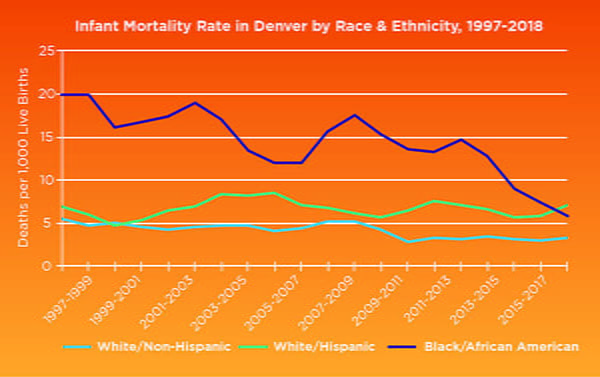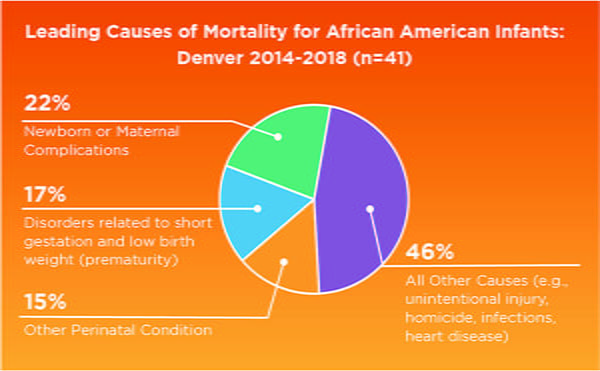African American Infant Mortality
A Look at Denver African American Infant Mortality
Infant mortality rates have been declining nationally and in Colorado, in parallel with significant public health efforts to improve maternal and child health (MCH). In Denver, infant deaths have been decreasing over time, and the largest decreases have been seen in the African American/Black infant mortality rate.

Over the last 20 years, the African American/Black infant mortality rate in Denver has decreased over 300% (from 20 per 1,000 to 6 per 1,000). During that same time frame, the White and Hispanic rates have remained relatively unchanged. Because the African American/Black rate has been declining faster than the White rate, the disparity (difference), between these two groups has also decreased over time. However, the current rate for African American/Black women is still twice as high as the rate for White women.
What is Infant Mortality?
Infant mortality refers to the death of a young child under the age of one year. Rates are calculated by counting the number of infant deaths for every 1,000 live births. Since these numbers are small in Denver, and often vary from year to year, a three-year average is used to calculate rates. This approach averages three years of data to create a more stable measure.
Leading Causes of Mortality for African American Infants in Denver
Newborn and maternal medical complications contribute to 22 percent of all infant deaths. Disorders related to prematurity and low birth weight comprise 17 percent. Other perinatal conditions (other diseases or disorders related to the time before birth through 28 days after birth) contribute 15 percent. All other causes, often affecting one or two infants, make up the remaining 46 percent. Some causes of death are preventable, while others are more difficult to address.

Factors Contributing to African American Infant Mortality Decline in Denver
The infant mortality rate is often used as an important indicator of the health and well-being of a community. Changes in infant mortality rates can reflect changes in a population’s demographics, or in the community’s overall health. In Denver, prematurity and medical conditions (e.g., genetic disorders) account for over half (54%) of the infant mortality burden. Because multiple health and social factors contribute to infant mortality, many approaches are needed to decrease infant mortality.
A recent analysis1 using data from 2008-2016 explored changes in Denver’s African American infant mortality rate. Although no single cause for the decline was found, a number of factors may be contributing, such as:
- Successful efforts to reduce teen pregnancies have resulted in decreased teen births, thus lowering pre-term and low birth weight babies, and decreasing infant mortality.
- The data show that over time more African American women completed a bachelor’s degree before giving birth. When mothers wait until adulthood to have babies, they are also more likely to have completed their education. Although higher educational attainment and higher income are social drivers of health and are associated with healthier moms and healthier babies, education and income do not fully resolve infant mortality disparity for African Americans.
- The Denver area is experiencing rapid change and gentrification. The data show evidence of geographic patterns consistent with community concerns about gentrification and displacement. Although migration might explain some of the changes in infant mortality, this phenomenon is difficult to measure with public data sources.
The causes of infant mortality are complex and interrelated. Stakeholders in the Denver area have dedicated increased attention in the last 5 years to addressing medical and social factors, such as the roles of racism and discrimination as fundamental causes of infant mortality. The most recent declines in the infant mortality rate may be attributed, in part, to increased attention to these medical and social factors.
We are employing a combination of efforts to stop preventable infant deaths, including education, health and social programs, and dedicated efforts to address racial inequities.
Partnerships between health care, public health, grass roots community organizations, employers, community members, and family advocates are all important in preventing infant deaths. Learning about these approaches and raising awareness in the community are ways we can all support women and families.
For more information or to partner with us, please contact denverpublichealth@dhha.org.
Last Updated:11/5/2019
References:
- Tri-County Health Department: Black Infant Mortality in the Metro Denver Region July 2019
Printable Resources:
Read our other Health Indicators:




